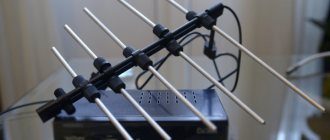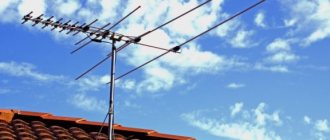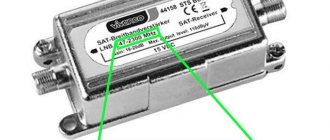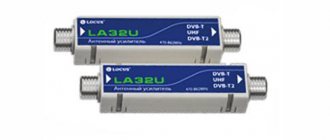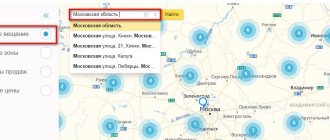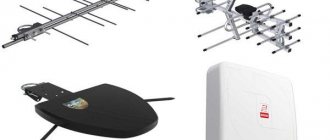According to the plans of the Russian Federation, digital television coverage of the entire territory of the country should already be implemented in full. Thus, currently, residents of many regions of the Russian Federation can experience all the delights of digital television.
Still, there may be cases when you need to find out whether there is coverage with a DVB T2 signal in a particular area, how to find a DVB-T tower, and even where to point the digital television antenna.
The current interactive map of CETV for all regions of the Russian Federation is presented here.
Digital TV coverage map
The transition to digital television is regulated by law by the Federal Program “Development of Television and Radio Broadcasting on the Territory of the Russian Federation” (also called the Federal Target Program).
The controlling body of this program is considered to be RTRS, which stands for Russian Television and Radio Broadcasting Network. There are RSRS branches in large regions of our country. The above-described government program pursues one goal – the development of the information space in the country. It also solves the problems of inequality between residents of individual cities in terms of access to radio and television channels.
For example, Nizhny Novgorod region. Before connecting digital television, almost half of the residents could only receive 4 terrestrial channels. After the introduction of digital TV, 97.3% of the population received access to dozens of high-quality TV channels completely free of charge.
What is it like?
The RTRS RF map is an interactive service that helps every citizen of the Russian Federation configure their TV to receive digital signals. With the help of such a service a person is able to:
- Find out about the number of operating multiplexes;
- Where are they available and in what direction do they broadcast;
- Frequency range of each channel package;
- Maintenance company of the selected TV tower.
Each television tower and repeater assigns a company engaged in technical maintenance and providing information on the operation of digital TV in the DVB T2 format.
Pros of digital TV
- Massive digital TV, which is absolutely free and easy to connect, offers its “clients” higher picture and sound quality. This is the very first and most important advantage of this type of radio and television broadcasting.
- The second benefit of digital TV is a large number of television channels, which is achieved through more efficient use of frequencies. So just one frequency can “fit” 10 or more channels (this is called multiplex). For 2021, depending on the region of Russia, from 10 to 30 TV channels are broadcast.
- In addition, digital television is also a set of additional useful functions such as “TV guide”, “teletext”*, etc.
*TV Guide - interactive TV guide of current and future programs. The TV guide also contains announcements and descriptions of TV shows, indicating their genres, time, etc.
*Teletext is a network television service that allows you to view text and simple images. Teletext is used to transmit news, TV programs, weather forecasts, etc.
Digital TV tower map
When selecting the “Digital Broadcasting” and “Frequency Zones” parameters in the system, the interactive map is painted in different colors, and the user has access to viewing data on a particular tower. In order to find out more detailed information, you should click on the region of interest and a specific tower.
Users have access to information about:
- Location of repeaters;
- Frequency zones;
- Physical channel number;
- Number of operating multiplexes;
- Television and radio companies servicing a particular tower.
Map of digital television of the Moscow region
Digital broadcasting of RTRS of the first type in the capital of Russia is divided into many single-frequency zones, that is, each such zone involves broadcasting multiplexes on one frequency. For many residents of the capital, the main TV transmitter is the Ostankino Tower.
Open coverage map
For certain reasons, in particular due to buildings and terrain, a high-quality signal from this source cannot be obtained in all areas of the city. The solution to this problem is to redirect the antenna to the repeater.
The signal from these towers is much weaker than the signal transmitted by the Ostankino Tower; such towers operate at a certain frequency. Note that in order to find and correctly direct the UHF television antenna, the user can be helped by online map algorithms.
Map of digital television of the Leningrad region
At the beginning of December in the Leningrad region, the broadcast of the second package of channels began in some other regions. Until then, the second multiplex was available only to residents of Tikhvin, Vyborg, and Gatchina.
Open coverage map
Digital television coverage map of the Sverdlovsk region
Currently, residents of the Sverdlovsk region have access to channels that are included in the RTRS-1 package. It is expected that by the end of this year the Sverdlovsk region will have full access to the second multiplex. So far, RTRS-2 is broadcast in cities such as Asbest, Yekaterinburg, as well as Serov, Nizhny Tagil.
Open coverage map
Map of digital television of the Samara region
Until 2021, two packages of channels were broadcast in the Samara region from four towers - Samara, Chapaevsk, Syzran and Zhigulevsk. Since January of this year, 50 television towers located in the region also began broadcasting 20 channels.
Open coverage map
You can always find out about details for other regions of Russia through the interactive map system .
What do you need to connect?
Digital television broadcasting in the Russian Federation is carried out in the DVB-T2 format. There are several important nuances that should be taken into account when choosing equipment for this format. Here are the most significant of them:
- To watch digital TV you will need a TV with a built-in DVB-T2 tuner. At the same time, it must have the Mpeg-4 video frequency compression standard and the Multiple PLP signal transmission mode.
- To watch digital channels on a regular TV, you will have to connect a DVB-T2 digital receiver to it, which must have the above parameters.
- Important! All DVB-T standard equipment is often advertised by unscrupulous sellers as “digital”, which is fundamentally incorrect. Such receivers WILL NOT receive digital channels.
- To receive digital channels you will also need an antenna operating in the UHF range. It can be either general (for example, located on the roof of a high-rise building) or individual (room or street).
Installation and direction of the antenna for terrestrial television of the new generation
The innovative standard on the territory of the Russian state is DVB-T2. To enjoy viewing the content provided by RTRS-1 and RTRS-2, citizens of the Russian Federation will need the following equipment:
- UHF antenna
- TV that supports DVB-T2 module
- Digital receiver (for owners of TVs that only support DBV-T)
To receive digital signals, you must have an indoor or outdoor decimeter antenna. For correct operation, point the antenna towards the repeater, the data of which can be found in the interactive map discussed earlier.
Experts advise installing a digital antenna on a windowsill, as this will allow you to achieve a high level of signal reception. Make sure there are no radio signal sources nearby as they will cause interference.
Interestingly, the presence of a multi-story building nearby does not mean that you are unlucky and because of this the signal will not be strong enough. High-rise buildings can also act as a signal reflector, on the contrary, positively influencing its power.
Installing an antenna under a metal roof can negatively affect the signal strength. When installing an outdoor antenna, care should be taken to install it firmly. Adjust the position of the antenna, guided by the technical data that is assigned to the tower that is closest to you - the exact location of the repeater, the distance to it, and the broadcast frequency can be found out thanks to the interactive map system.
It is important to know!
If your house is located quite far from the transmitting antenna, you live in a low-lying area or in an area with other terrain features, then it is best to:
1. Install an outdoor UHF antenna with a high gain.
2. Install an active antenna, that is, with a 5V or 12V power supply to the built-in or external amplifier.
It is recommended to install it at the maximum height and point it towards the transmitting antenna. To determine how far you are from a transmitting station, check the digital TV coverage map .
Tell friends:
Principle of operation
Terrestrial digital TV, unlike analogue, delivers channels by packaging them in a kind of package (often called multiplexes) on a single frequency, sending a signal from a terrestrial repeater. If we take Moscow into view, then two multiplexes are open here, and a third one is also operating in test mode.
Most Muscovites use signal reception from the Ostankino TV tower. But due to various factors that affect the quality of the transmitted signal, not all subscribers can receive a signal from the TV tower. To evenly distribute a high-quality signal, repeaters were used.
The disadvantage of repeaters is the weaker transmitted signal (unlike a TV tower) and its operation on a fixed frequency. Because of this, in order to view several multiplexes, you need to implement a signal simultaneously from a couple of repeaters.
A digital terrestrial television distribution map will help you find that same repeater. It shows repeaters and their coverage areas. With its help you will understand where to point the antenna to receive digital TV.
How to connect to digital terrestrial television
The implementation of the State Program “Digital Kazakhstan” is one of the priorities today, Ustinka LIVE correspondent reports. As part of the program, a project to switch to DTTV is being actively implemented with the direct participation and support of Kazteleradio JSC, the national operator in the field of television and radio broadcasting.
The main task in this important matter is the construction of radio and television stations. Now, out of 827 RTS that were included in the project, 546 have been built. Of these, 68 were operational last year: 13 in North Kazakhstan, 16 each in Kyzylorda and Karaganda, 8 in Atyrau, 6 in East Kazakhstan, 5 - in Aktobe, 4 - Akmola regions.
And the mountains will not be a hindrance
It must be said that a radio and television station is a tall tower that can reach 100 meters depending on the power. It's not easy to build. Due to safety precautions, climbing the antenna mast structure is prohibited in windy and stormy weather, Kazteleradio specialists note. On average, the construction of one RTS takes several months, provided the contractor has a certain number of workers and there are no problems with the delivery of equipment. However, due to the pandemic, construction was suspended and continued only in June. There are other difficulties.
“ For example, unscrupulous contractors win a tender and then do not fulfill their obligations under the contracts
,” explain representatives of the national operator.
— Construction often takes place in hard-to-reach places. Thus, 65 RTS should be built in the East Kazakhstan region, which are planned for construction in a short period in the mountainous areas of the region. Natural conditions prevent this. But Kazteleradio experts assure: no matter what mountains stand in front of them, the RTS will be built there!
In general, the project is moving forward step by step, and from February 1, the city of Almaty will completely switch to digital terrestrial television.
Also in the Republic of Kazakhstan, a number of regions have already switched to DTTV; analogue broadcasting has been switched off in Mangistau, Zhambyl, Turkestan, Almaty, Pavlodar, Kostanay regions and Shymkent. By December 1 of this year, the implementation of the project in Nur-Sultan and the Karaganda region will be completed. The project to introduce digital terrestrial television broadcasting is planned to be completed throughout the country in 2022. Don't forget to connect!
Experts from Kazteleradio JSC urge citizens to be extremely careful in matters of connecting to digital terrestrial television broadcasting. Due to the shutdown of analogue broadcasting in Almaty and the North Kazakhstan region, cases of consumers purchasing set-top boxes that do not support the DVB-T2 standard have become more frequent.
With the help of national operator specialists, we will tell you where to buy a suitable receiver and how to connect to digital terrestrial television, and answer all the most pressing questions from our readers.
?How can I find out if my TV supports the DVB-T2 standard?
— To do this, you can use the Yandex.Market website and enter the model of your TV in the search field. If your device supports the digital terrestrial broadcasting standard, then in the “All characteristics” section it should be written - DVB-T/T2 MPEG4. Most new TVs support the DVB-T2 standard. If the TV was released before 2013, then you need to buy a DVB-T2 digital set-top box. It is also called a receiver, or TV tuner. A decimeter antenna is also required. It’s easy to set it up via a receiver connection. To do this you need:
- choose a suitable antenna;
- select a TV tuner with the desired set of options;
- make connections according to the connection diagram.
?Which antenna to choose?
— Antennas can be indoor or outdoor. Residents of residential complexes can unite and install one antenna per house. In private houses within the city, you can use an indoor antenna, but only with direct visibility of the television tower. For residents of houses located far from a TV tower, an outdoor antenna is suitable.
?Which receiver to choose for digital TV?
— The choice of receivers is large, but only one fact is important for connecting digital TV - the DVB-T2 standard. Otherwise, receivers differ in connection methods (RCA, HDMI, SCART, etc.), as well as additional options. The complete set of the set-top box includes a power supply, remote control and instructions. The power supply can be external or built-in. The external one can be replaced in case of breakdown, the built-in one is less practical.
?How to set up an antenna and a DVB-T2 digital set-top box?
— The first step is to determine the location of the nearest tower.
To do this, use online services. The TSETV broadcast point closest to you can be found on the website tsetv.kz. Using the CETV coverage map, you can also see the transmission frequency of your channel package; the status will be indicated next to it - “broadcasting” or “waiting”. After this, decide on the location and method of mounting the antenna. Outdoor antennas must be pointed at the signal source to improve transmission quality. Attach the antenna to the balcony or window frame. Next, run the cable through the house to the digital set-top box.
?How to connect an antenna to a digital receiver?
— Turn off the TV from the network.
We connect the cable coming from the antenna, RCA or HDMI, depending on what you chose: one end to the set-top box, the other to the TV. We turn on the TV. Select the signal source AV, HDMI. The receiver menu window should appear. On the remote control this button may be called SOURCE, TV/VIDEO, INPUT. Select the menu items “Search” - “Manual search”. Don't forget to set the UHF band. Next you will see scales of signal strength and quality. Then we turn the antenna in different directions, choosing the ideal position, and attach the antenna. In the “Search” - “Auto Search” menu, the channels will be installed automatically.
Let us add that Kazteleradio JSC does not sell equipment for connecting to digital terrestrial television broadcasting. A list of dealers by region has been published on the official website tsetv.kz. You can review it and select the appropriate seller. If you have any additional questions, you can contact Call- at the following numbers:
193
(regional calls from a home phone are free)
8(800)080-01-93
(calls from a mobile phone are free)
What information can be obtained?
The digital television card will provide detailed information about:
- The location of each repeater. TV channel packages are broadcast from different TV towers due to the fact that a couple of multiplexes used everywhere were implemented with a difference of several years. Towers may not be located in one place, but at different distances and directions from the antenna installation site. Also, you can determine which is the nearest digital television repeater near me.
- Frequency zones. With their help, frequencies of excellent signal reception are determined. This option is useful if you are covering coverage from several repeaters and you need to choose which frequency is best for broadcasting.
- Physical channel number (TVC). Digital TV stores the channel in memory, and its frequency is specified in its parameters. To watch TV, just switch to the number of the specified software.
Additionally, the map will tell you what plans companies have for the near future to expand the radio and television broadcasting network of CETV. If the icon on the map is gray, the construction of the repeater and its commissioning have not yet been completed.
